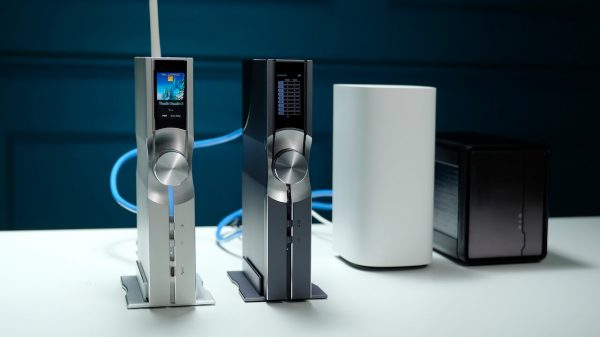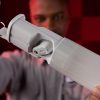At this year’s CEDIA Expo, about to enter its third day, it’s easy to get caught up in the “more is better” school of thought. More watts, more speakers, more pixels, bigger screens; more, More, MORE! And while I was very impressed by the Trinnov Audio demo, with its 43 speakers, 125,000 watts and million dollar+ price tag, there is one company that is bucking the trend, emphasizing quality over quantity as well as reasonable pricing over cost-no-object excess. That company is Theory Audio Design.
At CEDIA Expo, speaker design legend (and Theory founder and CEO) Paul Hales was on hand to show off some of the company’s compact but powerful speakers. Hales stated goal is to create speakers with consistent and accurate timbre across the entire line-up, from entry level to flagship. First up was the ic6 “in-ceiling speaker” ($675/each). I put the words “in ceiling” in quotes, because this versatile point source coaxial speaker is perfectly at home in a ceiling, in a wall, in a cabinet for surface mounting or even in a hanging pendant enclosure. Key to the success of the IC6 is the speaker’s high efficiency, high output and refined yet supremely dynamic audiophile approved sound.

You’ll also need one or more of Theory’s ALCs (active loudspeaker controllers) which are basically power amps with advanced built-in DSP. These start at $1,950 for a four-channel controller (model DLC-250.4), which is capable of driving up to sixteen Theory speakers.

The ic6 sports a coaxial design with Theory’s 1.4″ advanced polymer compression driver centered within a 6.5″ carbon fiber low frequency driver. Its rated frequency response is 68Hz-23KHz (-3 dB) or 58Hz-25KHz (-10 dB). It can be paired with one of the company’s subwoofers, but it performs incredibly well on its own. Sensitivity varies from 92dB to 106dB, depending on enclosure. While only measuring in at about 9 inches in diameter, each IC6 can reach up to 112 dB SPL.

Demos were held on the hour with standing room only in every session and many interested attendees turned away due to excess demand. Hales started the demo off playing music through just a single pair of ic6 speakers, mounted in the front wall. The fullness of sound, dynamic punch and sheer breadth and depth of the soundstage were quite frankly ridiculously good, particularly for a speaker system that cost about $1,350 (plus the cost of the controller/amp modules).
Hales pivoted to demo the same material on the ic6 in its pendant configuration, which only adds about $95 (per speaker) to the cost. I expected the pendant version to lack a bit of oomph, since it was free-floating in space (without the wall cavity as a baffle), but the bass response was surprisingly full, and the speakers projected a lively three dimensional image from 10 feet above the listeners right down to our ear level.

Moving along, Hales showed off the same speaker in a small cabinet enclosure, mounted from the rafters and pointing in toward the listener. The sonic character was virtually identical to its wall mount brother, with that same dynamic, wide open sonic presentation. Voices floated in space, bass guitar lines sounded snappy but robust, piano maintained a delicate yet dynamic presentation, snare drum had a crisp attack and bass drum had body and depth that belied the dimunitive size of the speakers.
Adding in one of Theory’s subwoofers, the new iws12-9 High Output Multi-Mount Subwoofer ($2,050) added significant heft and deep bass extension, without any hint of boom or bloat. Even free floating in space, mounted on the rafters next to the speakers, the sub provided deep extended bass that detracted in no way from the exceptional sonic character of the ic6 in its various configurations. Same sound, just with “mo bass.” The iws12-9 subwoofer is just as versatile as the ic6, with mounting options that include freestanding, surface mount or in-wall/in-ceiling. The iws-i9 measures in at about 34″x14″x9 while its brother, the iws12-6 offers similar performance in a longer, but shallower cabinet (14″x60″x5.5″).
Speakers for the Man (or Woman) Who Has Everything
After showcasing the ic6 in its various placements, Hales moved on to show off their latest speaker in the Pro Audio Technology line, the sr-2408iw. Developed for a certain billionaire’s mega yacht, the sr-2408iw, like the ic6, can be installed in wall, flush on wall, or on a bracket that allows the speakers to be angled toward the listening position. Its aluminum cabinet makes it ideal for marine use, but it’s equally at home inside your mansion or on your pool deck. Featuring a 1.5″ ring radiator tweeter, two high efficiency 4-inch midrange drivers, and an 8-inch long throw woofer, the SR-2408iw offers high output and high fidelity in areas where space is limited but performance is crucial. The cabinet depth is just 4 inches making it able to fit in virtually any wall or ceiling.

The SR-2408iw can be configured with 0-degree straight-firing axis (symmetric), or 40-degree asymmetric waveguides which aim the sound at a 40-degree angle to the loudspeaker’s main axis. This allows the sound to be aimed at the reference listening position while the speaker is mounted flush in a side wall. Mounted in-wall with its optional paintable grille this stealthy speaker is quite happy to be heard without being seen. And despite its 4-inch depth, the speaker is capable of reproducing 45Hz-22kHz without the help of a subwoofer.
While the ic6 was impressive, the SR-2408iw took everything to the next level: outstanding dynamic range, superb tonality, pinpoint, precise imaging and gut-wrenching bass from speakers that can virtually disappear into your room. Like the Theory speakers, each Pro Audio Technology speaker require a channel from one of the company’s ALC (Active Line Controllers) to power them up to reference cinematic levels (and beyond).
All This and a Cinematic Screen to Go With It
On the video side of things, a company called Jupiter provided one of their 105-inch flat panel LCD TVs for the booth demos. Jupiter is unique in that they only offer direct view displays in a 21:9 (2.37:1) ultra wide aspect ratio. Their 105-inch diagonal 21:9 monitor offered punchy, dynamic moving images which had no fear of a little ambient light. The 105-inch panel sells for a surprisingly affordable $13,000 while an 81-inch model sells for just $5,000. The company also makes even larger sized 21:9 displays using Micro LED panels.

Overall, the Theory Audio Design demo was one of the most impressive things I heard at this year’s show, and at a small fraction of the cost of many of the other rooms. Kudos to Hales and his team for the achievement.
Related Reading:








































Steffen styrbord
September 10, 2023 at 2:42 am
Bass respons was surprisingly full?? 68-58hz hardly qualifies as bass. Midbass yes full no. If you smoke enough before listening no still not
Repete
September 10, 2023 at 8:48 am
Bass frequencies encompass 0 Hz to 160 Hz. The “surprisingly full” is an opinion, and opinions are just like assholes; everybody has one. 😉
Ian White
September 10, 2023 at 12:00 pm
Repete,
Having listened to the Theory Audio system at home for 3 months using their active subwoofers, it’s everything Chris mentioned and more. Judging bass response at a trade show is not exactly easy considering the acoustic issues inherent with that kind of set-up.
I’ve known Chris for 25 years and take his assessment of equipment and systems as more than just an “opinion.” He knows a lot more than most and is far more critical of PR BS than 90% of the consumer A/V press.
After 25 years of this, I would buy the Theory Audio system over almost everything. Regardless of price.
Best,
Ian White
Chris Boylan
September 10, 2023 at 2:43 pm
Ian – Stop. Don’t feed the trolls.
repete
September 10, 2023 at 7:31 pm
Chris,
No disrespect intended. Please see my comments to Ian above.
Ian White
September 10, 2023 at 8:43 pm
It’s all good. Appreciate your response and that you read us.
I do agree that Chris is a fantastic writer. Almost as witty as his editor. 😉
IW
repete
September 10, 2023 at 7:28 pm
Ian,
Thank you. I really hope to be able to listen to the Theory Audio system in person someday. My traveling days are curtailed these days, unfortunately.
I did not mean to diminish Chris’s opinion in any way, shape, or form. His is a *qualified* opinion and I respect it and admire his writing.
After 60 years of playing, listening, and recording music, I am still fascinated by our efforts to reproduce “His Master’s Voice”.
Happy listening!
repete
Paul Hales
September 11, 2023 at 2:13 am
There is some confusion here. When we played the ic6 CEILING SPEAKERS alone, the bass extension spec is the 60Hz range. They sound remarkable full and powerful in that category. It’s a $600 6” ceiling speaker.
When we played them as Pendants we paired them with our iws12-9 compact subwoofer with extension to 24Hz and we rocked the house. Literally.
I would encourage your readers to go hear a Theory system before judging without any personal experience.
Ian White
September 11, 2023 at 11:02 am
Paul,
I would agree with that 100%. Some like to theorize without having actually been there or ever listened to the product.
Best,
Ian